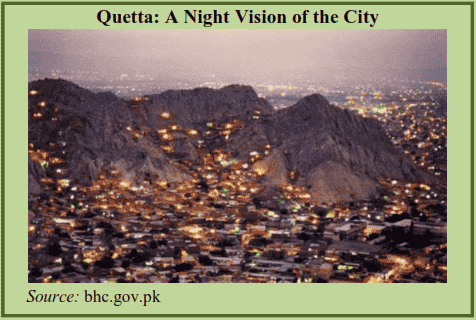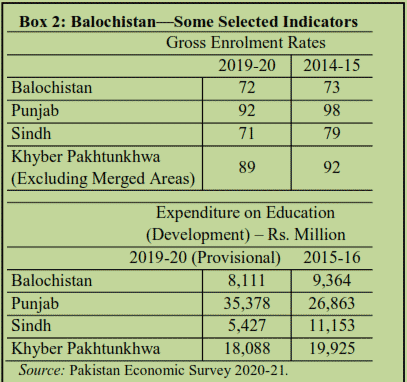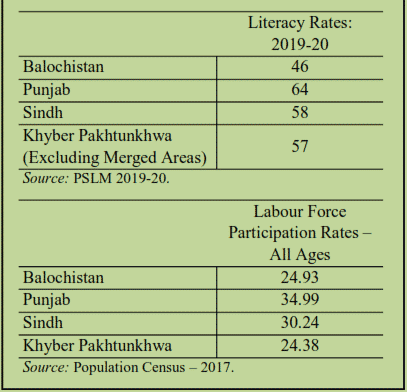
Pakistan Institute of Development Economics
- Home
Our Portals
MenuMenuMenuMenuMenuMenuMenu - ResearchMenuMenuMenuMenuMenuMenuMenu
- Discourse
- The PDR
- Our Researchers
- Academics
- Degree Verification
- Thesis Portal
- Our Portals
Balochistan: The Unrealised Potential
Balochistan: The Unrealised Potential
Omer Siddique, Pakistan Institute of Development Economics, Islamabad.
Mohammad Ahsan Achakzai, Balochistan University of Information Technology and Management Sciences (BUITEMS), Quetta.
Balochistan is situated at an important geostrategic position in the region. It is positioned on the cultural, socio-economic, and geographical crossroads of the Middle East, Central Asia, South Asia, and opposite to the Strait of Hormuz. These potentials could make the province an industrial hub with a massive private industrial investment. However, this potential has not been realised for a myriad of reasons. According to a rough estimation, around 21 million barrels of crude oil pass through the Strait of Hormuz daily (marketwatch.com). Balochistan shares a 900 km border with Iran and 1,200 km with Afghanistan, which “opens access to these mineral-rich and strategically important areas. It also marks an entry point into the resource-rich landlocked provinces of the Punjab and KP. Its geographical proximity to the oil and gas deposits of Central Asian regions adds to its strategic importance” (Gazdar, 2007: p. 8; quoted in Amad and Baloch, 2017). The important strategic location places Balochistan at the crossroad of a potential intra- and inter-regional trade.
However, various statistics (see Box 2) show that Balochistan is the least developed of Pakistan’s provinces. Even Quetta, which is the capital city of Balochistan and Pakistan’s fifth-largest city in terms of population, is lagging behind the other provincial capitals. While visiting Quetta as an outsider one notices that only major roads, telecommunications, housing, and schools (public and private, numbers are discussed not the quality) reflect expansion but other amenities like water supply and reservoirs, sewerage, waste collection, health infrastructure, new market development, and energy development show limited progress. Similarly, it is unfortunate to see hundreds of children in Quetta play on the street outside major sports facilities in the city, whereas the stadiums and playgrounds lie empty showing that these amenities are not accessible to the public.[1]
The question then arises that despite possessing precious resources (see Box 1), why Balochistan is still underdeveloped. Below, some broad-brush explanations are attempted.
| Box 1. Opportunities Abound · Fruits: apples, peaches, pomegranates Balochistan contributes 55-60 percent of cold season fresh fruits to Pakistan and 35-40 percent of vegetable varieties. · Fruit processing · “Quetta is known as the “fruit garden of Pakistan.” · Mining & quarrying: copper, gold, coal (260 million tonnes of sub-bituminous reserves in Shahrag, Harnai, Bolan, Quetta, Sibi, and Loralai), barytes, sulphur, marble, iron ore, quartzite, limestone · Huge potential in transit routes, coastal development. |
A BROAD PICTURE
(a) The Exploitation of Resources
One of the major complaints of the people of Balochistan is that although the province is resource-rich, the benefits of abundant resources have not accrued to the province’s residents, at least not to an average Baloch. The oft-cited example is that of the Saindak Copper Project. According to the agreement between the Federal Government and the Chinese company extracting resources, the Chinese company, is getting 80 percent of the profits, the Federal Government is 18 percent, and the Balochistan Government is getting only 2 percent of the total profits. (Ahmed, Mohammad, & Wadood, 2020).
Moreover, even the Hub Industrial Estate, which was established to increase investment and industrial activity in the province, has not benefitted Balochistan. Rather, it is an extension or subsidiary of Karachi-based industries. They have set up their businesses in Hub for seeking tax relief, which is allowed to the industries located in the Hub Industrial Estate. They do not provide opportunities to the people of Balochistan. Even the workforce that is employed in Hub comes primarily from Karachi and Sindh.
__________________________
[1] However, this problem of idle and wasted public assets is not peculiar to Quetta.
(b) Low Investment Rate in Balochistan
Balochistan has the lowest gross fixed capital formation (GFCF) in general government services among Pakistan’s four provinces. According to the Pakistan Economic Survey 2020-21, GFCF in general government services in Balochistan was Rs 144.5 billion, as compared to Rs 221.0 billion in Punjab, Rs 227.6 billion in Sindh, and Rs 183.8 billion in KP. A better indicator of investment is GFCF by the private sector but, unfortunately, such figures are not available at the provincial level in Pakistan. However, by looking at other indicators, such as literacy rate and labour force participation rates (LFPR) (see Box 2), one can infer that even private investment in Balochistan is quite low. Low LFPR indicates discouraged workers possibly because of lack of employment opportunities, whereas a low literacy rate signals a lack of skilled and learned labour force that can complement private investment. Low investment in Quetta and Balochistan is puzzling because, apparently, there are many investment opportunities in the region (see Box 1).
(c) Security Situation
While visiting Quetta one cannot help but notice the construction of new shopping malls and housing societies. At the same time, however, discussions with different segments of the society also highlight that not much investment is being done in other productive sectors. One of the main reasons cited for low investment is the security situation. Although the security situation in Quetta and Balochistan has improved recently, potential investors are reluctant to invest in the region. They fear that if the security situation worsens once again, they would not be able to recoup their investment. It is perhaps, for this reason, that most of the development that has taken place in Quetta is in the real estate sector, rather than in other industries that are supposed to be more productive. It is pertinent to mention that most of the investment in the real estate sector is being done by wealthy Afghan immigrants, which has driven up the real estate prices manifold.
(d) Difficulties in Transporting Traded Goods
With the closure of borders at Taftan and Chaman, informal trade (smuggling) between Pakistan and Iran, and Pakistan and Afghanistan has been severely affected. Before the closure of borders, the livelihood of thousands of people depended upon these trade routes but now they have lost their livelihood opportunities. It was revealed that, surprisingly, even when traders possess the proper import documents, the trucks containing imported goods are stopped at no less than 20 places starting from the Chaman and Taftan borders to other cities and provinces. It delays the merchandise reaching its destinations, increases the cost due to the speed money paid, and creates frustration among the traders.
(e) Lack of Education and Skills
Another problem highlighted by almost all the segments of the society is the lack of education and a skilled labour force in Balochistan and even in Quetta. Although education-related indicators—gross enrolment rate and development expenditure on education—are higher in Balochistan as compared with Sindh, they are quite low in comparison with Punjab and Khyber Pakhtunkhwa. What this indicates is that because of low education level, low literacy rate, and more importantly because of the quality of education, it is hard for potential investors to find a skilled and educated labour force in the province.
Our discussion with officials at the Planning and Development Department (P&DD) Balochistan revealed that although a substantial amount is being spent on hard education infrastructure, not much attention is paid to the quality of education, that is, on the “software”. In fact, the education system in the province is so inferior that those who can afford it would prefer to send their children to educational institutions outside the province to Karachi, Islamabad, Lahore, or Peshawar. However, since not everyone can afford to send their children outside Balochistan, the educational attainment and skills are very low in the province. The same is true of medical facilities in the province; with little affordability, most people prefer to take their sick loved ones to Karachi or elsewhere for medical treatment.
(f) Water Scarcity
Water availability has become a cause for concern for the whole of Pakistan but the situation in Balochistan and Quetta, which is the fifth-largest city of Pakistan, is dire. Quetta’s population has increased from 0.76 million in 1998 to 1.72 million in 2017. With the area[2] of 779 km2, this translates to a density of 2,211/km2. Apart from the trade through Chaman and Taftan borders, Balochistan’s economy is mainly dependent upon agriculture and livestock. According to an estimate, these two activities together account for almost 52 percent of provincial GDP and employ 67 percent of its labour force, with 80 percent of its population depending directly or indirectly on agriculture. Therefore, livelihoods in Balochistan rely heavily on agriculture, which in turn depends on the health of its groundwater (Dawn, 2018).[3]
__________________________
[2] Quetta City Tehsil.
[3] https://www.dawn.com/news/1401324
However, the water situation in Balochistan and Quetta is getting worse. Where amenities impact the quality of life, water availability is associated with survival—people in Quetta are worried about water availability. Hardly 20 percent of localities are connected to the WASA water supply system. While the government believes that Quetta’s water issue would be resolved through Mangi Dam, the business community believes that the Mangi Dam water will be diverted to Defense Housing Authority (DHA) Quetta. DHA Quetta is under construction and is believed to accommodate 30,000 houses in the next ten years. Thus, Mangi Dam might resolve the problem of water availability for the future DHA residents, the rest of the localities’ water problem would remain if it does not worsen. The lack of water availability is not only a cause of concern for households but is also a threat to the sustainability of agriculture, especially the apple orchards in and around the city of Quetta. The spread of real estate and water scarcity is driving the farmers away from apple cultivation.
(g) The Fishing Issue in Gwadar
Another issue that is at the forefront of tension is that of fishing in Gwadar. The Government has issued licenses to the Chinese and South Korean trawlers, who are allowed deep-sea fishing using nets, whereas the local fishermen are not allowed the same. It is alleged that the type of nets the foreign companies use are so tight that they not only catch fish but also fish eggs. This method of fishing is hurting the fish population and consequently the livelihood of the local fishermen. It is also alleged that the local fishermen are not allowed to fish after a certain time. The local fishermen argue that fishing is not like a 9-to-5 job and anytime, day or night, could be a better time to fish depending on the weather and other factors.
2. THE REASONS
The power structure in Balochistan is very complex, which has hindered socio-economic development in the province. One of the reasons for lower socio-economic development in Balochistan is a strong tribal hierarchy. In Balochistan, a vibrant middle class is missing. Instead, Balochistan is divided between a tiny but extremely powerful class of tribal chieftains and the remaining lower class, and a small group of public sector employees. The absence of the middle class, which can have an assertive politics to further its social and economic interest, is one of the main reasons for polarisation. In other words, one may argue that it is the power nexus of the state of Pakistan and the local elites and elected representatives that manoeuvre the governance in the province in such an exploitative way that only upholds and nurtures their political and economic interest at the very cost of common mass. Therefore, it will be plausible to argue that the current institutional structure is the construction of the political and economic supremacy of the tiny elite. And such an elitist political economy has created a rent-seeking oligarchy that has consolidated considerable economic and political power and drifted the provincial economy towards more exclusivity (Ahmed & Baloch, 2017).
| Box 3. Key Takeaways · There is mistrust between the people of Balochistan, including politicians and other stakeholders, and other institutions of the country. · The security situation or the perceived threat of terrorism is hindering private investment in Balochistan. · The real estate and construction sectors are flourishing but not the other productive/employment-generating sectors. · Investment in real estate is predominantly by wealthy Afghan immigrants. · Despite the presence of some quality higher education institutions, the overall quality of education is declining. · The water table in Balochistan, especially in Quetta, is receding, causing severe water insecurity. · Balochistan is the least developed of Pakistan’s provinces despite huge investment potential in: o fruit production, fruit processing, development of fruit value chain, mineral production and processing. o Intra- and inter-regional trade from Afghanistan and Iran because of Balochistan’s unique geostrategic position in the region. o Tourism and development of coastal areas. · The fishermen of Gwadar complain of the rough treatment they get at the hands of authorities. · The issue of Chinese and South Korean trawlers has further antagonised the fishermen. · Rather than encouraging private investment, the response to increase employment in Balochistan has been to provide direct employment in the public sector. |
| Box 4. Policy Options · Improve infrastructure in far-flung areas to facilitate access for fruits, agricultural produce, cattle, sheep, and goats to the market. · Rationalise water pricing to improve the water scarcity in Quetta and the rest of Balochistan. · Remove unnecessary security checkpoints to facilitate the transport of traded goods to other cities and provinces. · Set up storage facilities and food processing units in public-private ownership mode. · Give a fair share to the province in mineral extraction and production. · Provide land and utilities at attractive rates so that private investment is encouraged. |
3. CONCLUSION
Our discussion in Quetta made it obvious that the residents of Balochistan feel that they are not considered a part of the mainstream politics and economy. In fact, they feel that they are ostracised by design. There is, thus, a need to address and remove their misgivings. Balochistan is too important and large a province to be left hanging in the status quo. With the right policies and planning, and assimilating the residents of Balochistan into the mainstream, the province can play a substantial role in uplifting Pakistan’s economy. It has already played a huge part in Pakistan’s development by providing natural gas to the whole of Pakistan.
While our discussions highlighted the problems faced by Balochistan and Quetta, the discussions also made it clear that, despite the trust deficit, misgivings, and neglect of the province, the residents of Balochistan sincerely want to be a part of the mainstream politics and economy.
| The Closure of the University of Balochistan by Students’ Protest Teacher (to the protesting university students): “Why have you closed down the university and halted the educational activities? It does not happen anywhere in the world?” Students: “Sir! They have taken our fellow students to unknown places without any charges. Where else in the world does such enforced disappearcnes of students happen? |
REFERENCES
Ahmed, Manzoor & Akhtar, Baloch (2017). The political economy of development: A critical assessment of Balochistan, Pakistan. (MRPA Working Paper).
Ahmed, Aziz, Mohammad, Noor, & Wadood, Abdul (2020) Balochistan: Overview of its Geo-economic and Socio-economic Perspectives. Review of Applied Management and Social Sciences, 3(2), 235–246.
Marketwatch.com <https://www.marketwatch.com/story/strait-of-hormuz-the-worlds-biggest-oil-chokepoint-in-focus-as-us-iran-tensions-flare-2020-01-03>
| The knowledge brief is a result of interaction with different stakeholders during the PIDE team’s visit to Quetta and Ziarat in December 2021. The discussions with individuals and groups mentioned below provided invaluable insights into different socio-economic issues and woes, political intricacies, and the economic vision of the people of Balochistan and Quetta. · Vice-Chancellor BUITEMS, Quetta. · BUITEMS faculty and students. · Mr. Syed Zahoor Ahmad Agha, Governor Balochistan. · Mr. Mir Zahoor Ahmed Buledi (Planning & Development Minister); Mr. Mubeen Khilji (Science & Information Technology Minister); and Engr. Zamark Khan (Food Minister). · Other current and former politicians. · Planning & Development Department officials. · Ministry of Finance Officials. · Quetta Chamber of Commerce & Industry (QCCI) office bearers and members. · Members of Rotary Club, Quetta Chapter. |







